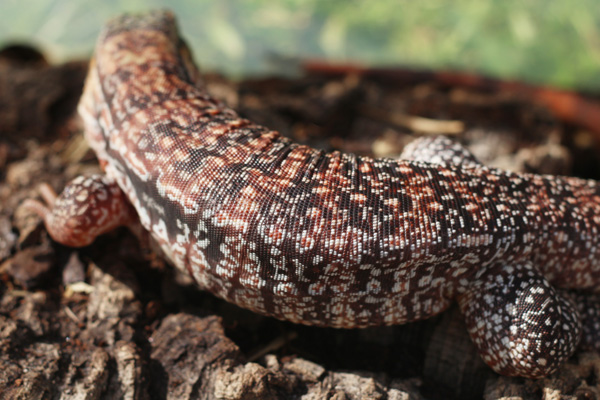I wrote about keeping feeders as something that comes naturally in this hobby, (buying insects in bulk and breeding them is such a money saver) but I've never gone into how to keep insects successfully. So I will do that now, and give a quick tutorial on how to keep some of the common feeder insects - crickets, superworms, roaches, butterworms, and hornworms.
Crickets & Roaches
We'll start off with the most common feeder insects, crickets and roaches. And to calm any fears, I don't mean the wild roaches that scurry across your basement at 100 mph. I mean roaches like discoids or dubias, captive bred roaches that don't climb smooth surfaces, fly, or lay eggs. Yes, icky but much better! Let's talk about what you'll want to keep your crickets and roaches in.
Some people like using aquariums, but I much prefer plastic storage bins. Not only are they cheaper, but they weigh less, and you can drill holes or cut out panels. I live in warm Florida, so I do not need to provide my roaches with a heat mat, but if you do decide to add a heat mat to the bottom of a container, make sure you don't risk melting or fire.
I needed new containers for my crickets so I bought these large (70 L) containers on sale from Target that were very square, so they have more ground surface area. For crickets, I personally do not do anything as far as ventillation - I usually just leave the top off, and this is enough to keep the air moving in the bin. But if you're keeping them in a more stagnant place, like a garage or basement, you will probably benefit from cutting out at least 2 side panels and glue metal mesh, to keep the air cleaner. This will reduce your die-offs.
For roaches, I keep the lids on but will cut off a panel from the top and glue mesh to it. I am much more worried about the roaches somehow escaping or being knocked over! To keep your colonies healthy, whether they are crickets or roaches, try to spread out your numbers. So instead of having 1,000 in one medium bin, separate them into two/three. Keeps each bin cleaner, the insects from crowding each other, and you'll have less die-off. And inside your bins you want to provide lots of egg-crate, for example.
BREEDING
I am not going to go into breeding crickets very thoroughly because I never do it to raise anything but tiny pinheads for babies, but the only think you need to provide is another shallow dish or tupperware full of moist, organic soil (no pesticides!) The adult females will flock to lay their eggs in the container, and after a couple days I remove the container, put a lid on it, and let it incubate in a warm room for about 10-14 days.
Roaches, however, are much simpler. Species like dubias, discoids, cave roaches, and the like are live-bearers, so every month or so adult females will give birth to a few dozen babies. When provided with a comfortable bin, food, and warmth, breeding adults will continuously provide you with new baby roaches.
Superworms
Superworms are something that I try to always have on hand. They live for a long time and are easy to breed if you want to. For these worms, I prefer to use shallow plastic containers, like the kind meant to store sweaters or shoes under the bed (pictured right). They need more ground surface area that anything else, so I prefer these bins to anything else. If I am not getting that many superworms I will just leave the floor bare, but if I am getting 500-1,000 then I will provide a layer of gain-based bedding for them to eat and crawl around in. Because their food is often times mixed with their moist food (fruits and veggies), ventilation is important. Otherwise you'll end up with big, moldy and moist areas in the bin and it will be a nightmare to pick out the worms from that. So I either leave the top completely off, or cut out a ventilation panel from the lid.
 |
| When I don't get so many superworms that I worry that they'll crowd each other, I don't use a bedding and just provide lots of food. If I were putting several hundred in here I would. |
BREEDING
To breed superworms, they must be adult sized. The curious thing about superworms is that they will not pupate unless they are completely alone, so they must be separated into individual little cups, tackle box compartments, etc. and then placed into a dark place. Typically, within a few days you will see them turn into an Alien movie-looking thing, in which the worm will develop into a beetle. 2-3 weeks later, a black beetle will emerge and you can place them all together into a breeding container.
The beetles will lay their eggs in something like chunks of potato, so I will provide potato and then remove them to a different container after a couple days. And eventually, small worms will emerge. But the potatoes need to be removed or the adults will simply eat them. That is why I usually provide more exciting food, such as fruit or hibiscus flowers, to encourage them to eat something besides the potato.
Feeding Your Crickets, Roaches, & Superworms

Once you have the bin ready, it's time to feed your insects! Keeping them well-fed and hydrated will keep them alive and breeding properly, and will provide your reptiles with more nutrition. So it's important to pay attention to what you feed your insects. I highly recommend getting together a good dry gutload, whether it's commercially bought or home-made.
The one's I've tried and recommend are:
- Repashy Superload or Bugburger
- Dinofuel
- Cricket Crack
I currently use Superload and like it very much. I will take a shallow dish, like the top of a Chinese take-out container, and make it half dry gutload food and half fresh fruits and veggies. With crickets, providing any sort of standing water is a nightmare as they will all manage to drown themselves. So they get their moisture from their food. The roaches are more intelligent and do sometimes get another shallow dish with a thin layer of water which they will all drink from. I put all the food on a dish because then it's much easier for me to reach in and remove anything that went uneaten. This helps keep things clean and my crickets tend to live longer when everything is fresh and clean.
With superworms, I do not use a dish as it just sinks into the bedding. But providing hydration via fresh fruits and veggies is vital, so I always have chunks of fruits or vegetables in their bin and I just have to be diligent about scooping out any uneaten chunks the next day.
 |
| Dark leafy greens (like collard or kale), carrots, pears, zucchini, squash, beet, etc., all make excellent choices for fresh food. |
Hornworms & Butterworms
Both of these worms are great, in my opinion. I try to always have a cup of at least one of these worms at home, as all of my chameleons just go crazy for them. Both worms are available for purchase in cups, typically in quantities closer to 20-25 individuals per cup. Butterworms come in a cup of wood shavings but not with any food - they are hard to feed, but will eat steamed sweet potato or squash. However, the benefit is that they are naturally very high in calcium and can be kept in the fridge, so they are very convenient.
Hornworms will come in a cup of pre-made food mix, which they will eat eagerly. They can also eat mulberry leaves, but never give them tomato leaves! These are toxic. Hornworms also grow to a tremendous size within a few days in a warm home, so make sure to feed them off quickly. These food cups typically do not come with enough food for all 20 individuals to grow to full size, so it's important to either order extra food if interested in growing out worms to breed or to feed off the larger worms so the smaller ones can eat and grow.
BREEDING
Butterworms cannot be bred, as they are considered pests and are radiated before coming into the US. But hornworms, while also pests, can. I will not go into detail on how to breed the moths, as I have never done so myself, but to get moths the worms must eat and grow until they reach maximum size and stop eating. If raising lots of worms, it might be prudent to order extra food. It's clear when they have stopped growing, as they will usually stop eating and drop to the bottom of the container and become restless, which means that they are looking for somewhere to bury themselves.
So at this point I will take a large tupperware with several inches of organic, moist soil and place the adult worms into it. They will bury themselves into the soil and change into maroon pupa. Some may not survive, but most of mine typically do. 2-3 weeks later, the moths will emerge, and they will need to be moved to a much large cage so that they may stretch out their wings, take flight, and start eating. I have only ever been interested in using the moths as food for my larger chameleons, so unfortunately, you will have to find a more thorough tutorial on how to breed hornworms.














